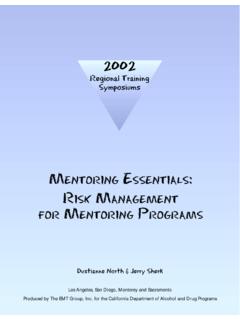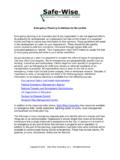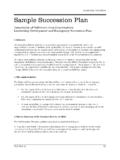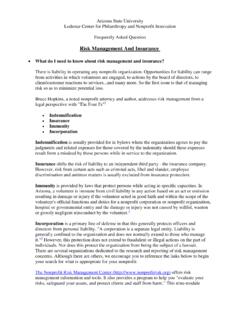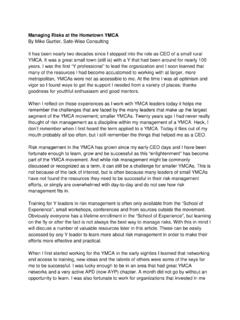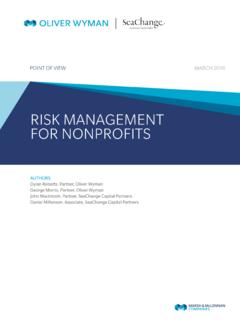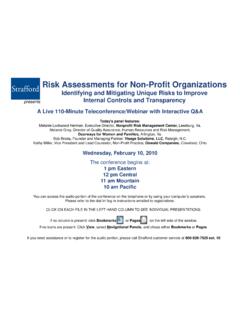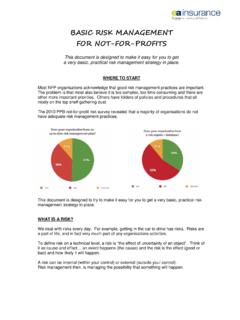Transcription of How Nonprofit Organizations Can Manage Risk1
1 How Nonprofit Organizations Manage Risk Authored by: Ron Matan, CPA Bridget Hartnett, CPA Published Summer 2011 ABSTRACT The objective of this white paper is to define risk as it applies to the Nonprofit sector, identify the key areas of risk unique to these Organizations and provide a detailed analysis of the types of risk faced by the Nonprofit community. The authors include suggested methods and processes for efficiently and effectively managing the juggling act required by all Nonprofit leaders to balance risk and reward. Table of Contents 1. Define Risk management and Enterprise Risk management for Nonprofit and Social Services Organizations 2. Provide a Detailed Analysis of the Areas Vulnerable to Risk in the Nonprofit Community 3.
2 Discuss Solutions for Managing and Balancing Risk and Reward 4. Case Study 5. Sample Risk management plan 6. Conclusion 7. Citations 8. About the Authors 9. About Sobel & Co. 1. Define Risk management and Enterprise Risk management for Nonprofit and Social Services Organizations A recent article, Increasing Risk Awareness for Mission Critical Objectives of Nonprofit Organizations , published by the America Institute of Certified Public Accountants (AICPA), states, ..greater risk awareness is becoming an expected best practice in overall governance of an organization . Knowing that Organizations , including not-for-profits, must assume risks if they want to further their mission, executives are now seeing the strategic value of being more informed about those risks that might positively or negatively affect their mission goals and objectives.
3 It is obvious that the Nonprofit community is as susceptible to the dangers posed by potential risks as they work to achieve their goals, as is the for-profit business community. However, the concept of risk and risk management is seen through a unique lens when applied to the Nonprofit sector because, unlike the corporate world where business owners and CEOs determine policy, in the Nonprofit world so many of these critical decisions are left to the volunteer leadership, such as board members, and to paid staff. It is this group of Nonprofit influencers who will be ultimately held responsible for deciding how conservative or adventurous the Nonprofit should be, what approach to take regarding managing risk, and how the risk can be shared by the organization s stakeholders.
4 This distinction between the for-profit and Nonprofit decision makers is important to bear in mind Risk management is defined as the process that is adopted to plan for the possibility that events may cause harm to an organization , focusing specifically on risk associated with board members and volunteers, staff, programs and events, services offered, operations, technology and financial management Enterprise Risk management (ERM) as a process goes one step further, enabling Nonprofit leaders to ensure that their objectives are being met while identifying and managing both internal and external risks across the entire organization . By analyzing the vulnerability of the entire enterprise, the leadership is able to link all of the related risks to the organization s key initiatives and by doing so can better and more efficiently mitigate the impact of risk within each circumstance.
5 For the purposes of this white paper, risk is more broadly defined and complex than simply ensuring protection against disaster by instituting Directors and Officers insurance policies, safeguarding funds, or obtaining the accurate coverage in the organization s Property and Casualty plan . While it is more common to focus on insurance policies that safeguard the organization from law suits of all kinds, nonprofits also need to address the more subtle risks that are often taken to enable them to achieve their mission. If, for example, they assume too conservative an approach they may follow a path that limits the ability of the group to reach its goals.
6 On the other hand, an unreasonable amount of risk may be equally as poor a strategy. It makes more sense that nonprofits that integrate corporate governance, strategic planning and risk management are better able to meet their mission and achieve their vision as they strike a balance between pursuing their growth goals and addressing the risks related to those initiatives. Each organization can scrutinize the most obvious areas that are likely to have risks associated with them such as strategic activities, financial activities, operational activities, compliance initiatives and reputational concerns. According to Charles Tate, in an article entitled So What is Risk Assessment?
7 These activities can be defined as follows: Strategic activities which include the quality of programs, the organization s physical capacity, the success with which the Nonprofit achieves its mission, the demographics of donors, the transparency of the group, and the management of the changing expectations of donors, clients and staff, especially when funders are seeking quantitative measurements as proof of impact and different outcomes prevail rather than as initially anticipated; Financial activities which include efficient use of office space, personnel, deferred capital maintenance, cost of capital (debt), cost of programs and services, management of endowments, cost of new technologies and the use of all resources; Operational activities which include systems related to finance, technology and administration along with internal controls, security, internet access, electronic records (ex.)
8 , donor databases), human resources and succession; Compliance concerns which include regulatory accountability and implementation of processes that can impact the ability to attract federal funding, tax exemption status, and contracts; Reputational concerns which include mistakes in any of the above areas, leading to damaging or diminishing the organization s reputation and perhaps future fund raising. 2. Provide a Detailed Analysis of the Traditional and Non-Traditional Areas Vulnerable to Risk in the Nonprofit Community Identifying and assessing areas at risk is a key to managing the process for nonprofits, especially as new, more complex assessments are proving to be important for decision making.
9 Nonprofit leaders must keep an eye on traditional sources of risk while also learning to link mission critical strategies with key risks . Reviewing the organization s top strategic initiatives (programs, events, service offerings) is one way to begin identifying those areas of greatest exposure for the group. Here are some of the most common areas that have a high potential for risk: Special Events and Other Fundraising risks A Nonprofit can be at risk on several different levels regarding both individual fundraising and fund raising through special events. When hosting a major event such as a Gala, a blood drive, a golf outing, a Bowl-a-thon or any other similar program, there is always risk attached.
10 No matter how well planned, the event can be a disaster if anything goes wrong. To side step the possibility of risk, the Nonprofit can adopt some preventative measures when preparing for any event. To begin with, the event must be mission appropriate. Keep in mind that the event represents the organization and supports its vision. The event must be carefully crafted and thoughtfully executed so that it can not only promote the organization but also meet its social and financial goals. The bigger the event, the bigger the audience, thus the more planning that is required for success. To accomplish this, there should be an event director and a committee, whenever possible, devoted to planning, directing and managing every logistic detail and ensuring continuous communication.



